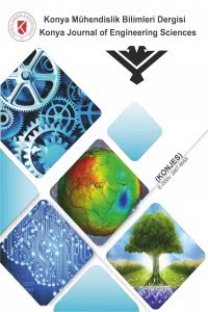Değişik uçucu küllerin yüksek plastisiteli kilin serbest basınç dayanımına etkisi
Bu çalışmada, İzmir Çiğli Jet Üssünden temin edilen bir tip yumuşak kilin, iki farkh uçucu kül ile stabilizasyonu üzerine bir deneysel araştırma sunulmaktadır. Bu amaçla, kuru-kil ağırlığının % 5,10, 15 ve 20'si oranlarında uçucu kül içeren farklı uçucu kül-kil karışımları hazırlanmıştır. Katkısız zemine ek olarak, kireç içeriği farklı iki uçucu külden yukarıda verilen oranlarda kül eklenerek hazırlanan dörder numunenin Standart Proktor deneyi ile optimum su muhtevaları ve maksimum kuru birim hacim ağırlıkları belirlenmiştir. Optimum su muhtevasında sıkıştırılarak hazırlanan uçucu kül-zemin numunelerinin, 1, 7, 28 ve 90 günlük serbest basınç dayanımları ölçülmüştür. Deneysel çalışma sonunda, eklenen uçucu külün zeminin serbest basınç mukavemetini artırdığı görülmüştür. Bu artışın uçucu kül tipine bağlı olarak değişimler gösterdiği tespit edilmiştir. Artan kül içeriği ve külün kireç içeriğine bağlı olan bu artışlar, puzolanik reaksiyon, uçucu külün boşlukları doldurma etkisi ve uçucu külün serbest kireç içeriğinin etkisi ile açıklanabilir.
Effect of different fly ashes on unconfined compressive strength of highly plastic clay
This paper presents an experimental investigation into the stabilization of a soft clay obtained from a military zone in Izmir with two different fly ashes. 5, 10, 15 and 20 % by weight of the soil was replaced with fly ash. In addition to the neat soil sample, the optimum moisture contents and maximum dry unit weights of four soil-fly ash mixtures prepared from each fly ash were determined by Standard Proctor Tests. The unconfined compressive strengths of the samples prepared at optimum moisture contents were determined at 1/7,28 and 90 days. It was found that, inclusion of fly ash improved the properties of the soil. The improvements were more pronounced with increasing fly ash content of the mixture and lime content of the fly ash. The fact was attributed to the pozzolanic reaction and pore refinement effect of fly ash as well as its free lime content.
___
- 1.Alkaya, D., 2002, Uçucu Kül Katkısının Dolgu Zeminlerin Stabilitesine Etkisi, Doktora Tezi, Pamukkale Üniversitesi, 242 s. 2.Al-Abdul Wahhab, H.I., Asi, I.M., 1997, "Improvement of marl and dune sand for highway construction in arid areas,Build. Environ., 32, 3: 271-279. 3.Hausmann, M.R., 1990, Engineering Principles of Ground Modification, McGraw-Hill, Singapore, 632 s. 4.İnan, G., Sezer, A., 2003, "Zemin iyileştirme yöntemleri ve kullanılan malzemeler üzerine bir inceleme", MBGAK 2003, İstanbul, 369-376. 5.Joint Departments of the Army and Air Force, TM 5-822-14/AFMAN 32-8010,1994, Soil Stabilization for pavements, USA, 57 s. 6.Kaniraj, S., Havanagi, V.G., 1999, "Compressive strength of cement stabilized fly ash-soil mixtures",Cement Concrete Res., 29, 5: 673-677. 7.Kolias, &., Kasselouri-Rigopoulou,' V., Karahalios, A., 2005, "Stabilization of clayey soils with high calcium fly ash and cement", Cement Concrete Comp. (Article in Press). 8.Mitchell, J.K., 1976, Fundamentals of Soil Behavior, John Wiley and Sons, New York, 422 s. 9.Prabakar, J., Dendorkar, N., Morchhale, R.K., 2004, "Influence of fly ash on strength behavior of typical soils", Constr. Build. Mater. 18, 4: 263-267. 10.Savran, K.Z., 1988, Stabilization of Cohesive Soils with Fly Ash, Yüksek Lisans Tezi, ODTÜ, 62 s. 11.Turner, J.P., 1997, Evaluation of Western Coal Fly Ashes for Stabilization of Low-Volume Roads, Wasemiller, M.A., Hoddinott, K.B. (editörler), Testing Soils Mixed with Waste or Recycled Materials,ASTM STP 1275, Pennsylvania,340 s. 12.Umar, F., Ağar E., 1991, Yol Üst Yapısı, İTÜ İnşaat Fakültesi Matbaası, İstanbul, 339 s.
- ISSN: 1300-5200
- Yayın Aralığı: Yılda 4 Sayı
- Başlangıç: 2018
- Yayıncı: -
Sayıdaki Diğer Makaleler
Değişik uçucu küllerin yüksek plastisiteli kilin serbest basınç dayanımına etkisi
Gözde İNAN, ALPER SEZER, KAMBİZ RAMYAR, H. Recep YILMAZ
Mehmet ARSLAN, ZAFER ASLAN, ABDURRAHMAN DOKUZ
Mono IKONOS uydu görüntülerinden konumsal verilerin elde edilmesinde doğruluk ve maliyet analizi
Kayseri kent bütününün açık ve yeşil alanlarının sistem yaklaşımı ile değerlendirilmesi
BANU ÖZTÜRK KURTASLAN, Murat E. YAZGAN
Konya yeraltısularında klorlu fenoller
MEHMET EMİN AYDIN, Senar ÖZCAN
Dijital ortofoto haritalarda konum doğruluğu ve maliyet karşılaştırması
